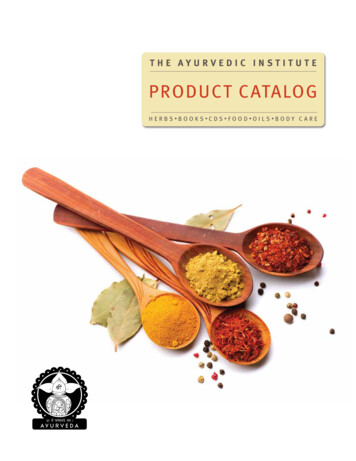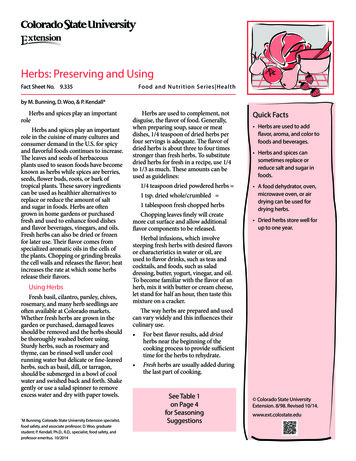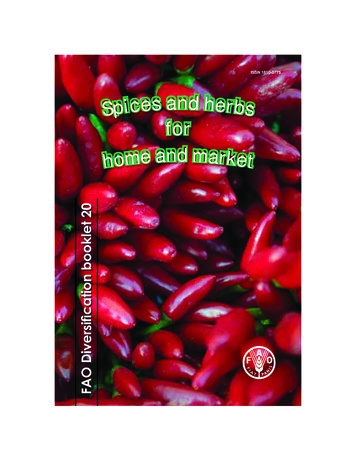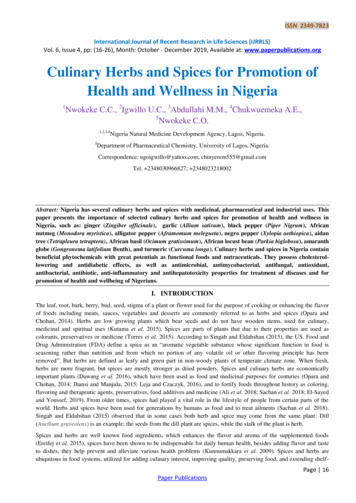
Transcription
FOR THE LOVE OF HERBSBy D. Nangle of The Big Green Directory (www.thebiggreendirectory.co.za)I love having herbs in my garden. Friends often comment on how I have mixedthe herbs into my garden for effect and for insect control.Herbs are so versatile in gardens. I grow them amongst my roses (mint andlavender) to deter aphids and leaf eating insects, I plant herbs that revitalize thesoil continually so I don’t need to compost areas as frequently as most gardenersdo, and I use them for a variety of medicinal and culinary purposes as well.About 18 months ago, I visited Margaret Roberts Herbal Centre in theMagaliesberg and felt very privileged when she sat down with me and took thetime to talk to me personally. She and my Mum are the same age, and I have toconfess that the year they were born in yielded a great human vintage. I havemany of her books on my shelf, which I regularly consult, one I have had for over20 years from when I first began gardening and falling in love with herbs. In factevery gardener (in my humble opinion) should have Margaret Roberts A-Z ofHerbs, and I have recently acquired another really awesome book called JanesDelicious Garden (by Jane Griffiths) and these 2 books are my constantgardening companions and guides for herbs (and growing vegetables in yourgarden). So the information I am sharing with you today has been learned andgleaned from these two reference sources, and all credit to them for sharing thisinfo with us. These are 2 books I consider “must haves” and make greatgifts. Both give you recipes for insect control and Margaret Roberts’ book givesyou the medicinal and cosmetic and domestic uses.
Today, I have chosen 5 herbs to talk about that I feel add value to every garden,home and medicinal chest. They are not the usual herbs that are householdnames because anyone who cooks or gardens knows those. I want to talk about“little treasures” that are often overlooked for their more publicizedcompanions.Nepeta mussinii and N. cataria, Catnip, CatmintGrows to:Containers:Likes:Soil pH:Transplant:Hardiness:Water:Spacing:N. mussinii 15-30 cm, N. cataria varies between 30-90 cmSuitable for pots (Perennial)Full Sun – semi shade, well drained loamy fertile soilprefers 6.5-7Sept-DecHardyPlenty of moisture30-35 cm
To quote Margaret Roberts: “Aphids can’t stand it”. This plant is very attractive (if youcan keep your cats/neighbours cats out of it). N. mussinii (the smaller variety) is lessattractive to cats and has beautiful bluish/mauvish flowers and grey stems and leaves,and looks fabulous as a border. It is also great as a hanging basket plant choice.You can also plant it around exotic plants like roses to deter the Aphids, sap-sucking andleaf munching insects. Imagine yellow roses with a swath of purply/blue groundcoverunderneath it. Too stunning! If you plant this in your veggie patch, it will help detercertain beetles.Rose with lavender and mint protecting it.This herb attracts bees and butterflies, which are fantastic if you are into growing yourown vegetables and producing open pollinated seed for the next season. Bees andbutterflies provide a free pollinating service, so if you plant this herb between rows ofveggies that you are open pollinating, you get the insect repelling qualities as well as thepollinating service.Uses:
Toys for catsRepels rats and insects (spray)As a tea, it can be used to combat varicose veins (see Margarets recipe for thisone in her book)Vitamins – the leaf and flowering top are rich in Vitamin C.An infusion can be made to relieve colds and fevers – it induces sleep andperspiration without increasing the body temperature.Good for treating restlessness (again an infusion), colic and bedwetting inchildren.Pain reliever – digestion and menstruation.Meat – rub on meat to flavour it before cooking.Salads – young shoots can be used only in small quantities as they have astrong flavourHow do you keep cats out of it? Grow a patch closer to the house and leave it open forSnookums to go “ga-ga” over. He/she will go there first rather than stroll further afield forits ‘daily fix’!Symphytum officianale, ComfreyGrows to:Containers:Likes:Soil pH:Transplant:30-60 cmSuitable for potsFull Sun – semi shade, average soil, needs moisture to thriveprefers 6-7Sept-March
Hardiness: Roots are hardy, tops die down when frosted.Water:Plenty of moistureSpacing:1mPropagation: Take pieces of root, keep root moist till establishedInsects:Will attract bees to your garden.Good for: Swampy ground or badly drained areas.Now this “little treasure” has really captured my heart. We were given a plant by a friendof my husband’s (Lisa Sutherland) when we were establishing our first veggie garden.This poor plant struggled where we planted it, and when we moved house, I decided totake it with as I valued the leaves composting qualities so greatly that I just could notleave it behind. I planted it at my new house and it rallied, then didn’t, and did, thendidn’t. Then my Scottie had 7 puppies who decimated this area, and I performed anemergency rescue on all the plants left unscathed, and put them into pots. Well waddayaknow just look at this beauty! It just loves living in this pot, so I guess that is where itis going to stay now.Why comfrey as a special plant. Well let me share how awesome it is with you. It shouldbe grown in every organic veggie garden as it is one of the most amazing naturalfertilizers out there. Its leaves have 2-3 times more potassium than kraal manure. It ishigh in calcium, nitrogen and beneficial minerals. This is a great fertilizer for tomatoesand potatoes. Its very deep root system mines these from the soil, as it reaches furtherthan other vegetables to access them.How to make Comfrey fertilizer:Trim leaves and soak in water for 4 weeks. Drain off the liquid, store in a 5 litre plasticwater bottle, keep out of the sun (if you have excess). I peronsally use a 50 litre plastic
container when I am growing tomatoes (potatoes take too long for me personally and Ineed more land before I attempt them again). Warning, they will ferment and smell foul,but tomatoes and potatoes just love it. You can mix in some vermiliquid to the mix whenapplying and voila! You have a fantastic fertilizer and plant tonic to feed your plants with.For the gardener who would prefer not to brew the tea, you can cut up the leaves (chopthem) and mulch around the plants after leaving them to stand for at least 48 hours afterharvesting. I have taken Janet’s advice and tried lining planting holes (after they havewithered for 2 days) with them, and the plants have just taken off. The leavesdecompose and become a rich fertilizer for the plant.A word of caution though, this plant self-proliferates, what was one plant is now 4 in thepot. If the flowering stem is used to compost, they can root themselves, so just be awareof this when harvesting the plant for its composting qualities.Other uses: The leaf/root can be added to a bath to soften the skinBruises, swellings and sprains – chop 3-4 comfrey leaves finely, soften with hotwater and apply to the affected area on a square of lint. Cover with plastic and abandage to keep in place. Leave on as long as possible. Repeat if needed.Comfrey Oil – skin irritations (recipe is in Margarets book).Insect bites and stings – rub the juice of the leaves onto the bite/sting to sootheit.Insect repellentGout remedy – please refer to Margarets book.Margaret recommends it to treat ulcers, tuberculosis, pneumonia, ruptures, burnsand bruises. She has a remedy in her book for this.Pelargonium Species, commonly called “scented geraniums”Grows to:Containers:Likes:Soil pH:Transplant:Hardiness:Water:15 - 120 cm depending on speciesSuitable for pots, good indoor plantsFull Sun-semi shade, welldrained fertile loamy soilprefers 5-7.5Aug-NovTender to semi-hardyDrought tolerant, water during dry weather – once a weekin potsat least.Spacing:Varies according to speciesPropagation: Seedlings and cuttingsInsects:Flowers attract beneficial insects. Repels leaf eating insectsGood for: Hedging plant, potpourri.Note:Does not tolerate frost, rather put them in pots if you can,or cover if you are expecting frost.
P. graveolens (Rose)P. Limonseum (Lemon)My favourite is the rose geranium variety (P.graveolens). I have them in pots by thesteps to my front door and as I pass by each time, I rub a leaf and breathe in the headyaroma. I have taught my daughter to pick the leaves, bruise them and rub them up anddown her arms and legs when there are a lot of mozzies and flies. She now picks themand gives them to guests on arrival or departure, which they love. It gets quite leggy, butI wait for new shoots to appear at the bottom, and then I cut the whole thing back and inno time at all it is looking plush again.There are several varieties of this lovely herb, peppermint (P. tomentosum), Applegeranium (P. odoratissimum) and Lemon (P. Limonseum). The camphor leaf geranium(P. betulinum) smells like camphor.What makes this one special? This is a pure pleasure plant for me. The rosegeranium smells beautiful firstly, but it also can be used for a variety of different things: Use on greasy or paint stained hands to remove the dirt effectivelyAs an essential oil it is added to face creams to balance the oil production in oilyand dry skins. It is also used in aromatherapy massage and benefits PMS, fluidretention, eczema, dermatitis and dry skin. An infusion of leaves is effective against dysentery and diarrhea.P. graveolens is well known as an anti tension herb, aids sleep and relaxation,soothes digestion. Put some into your pillow case.The camphor scented geranium is great for clearing coughs, blocked noses andchestiness. Pour boiling water over bruised leaves and inhale.Salads: Flowers can be tossed in salads.Baking and food flavouringDrinks: Peppermint is delicious in drinksApple geranium for apple dishes, and Lemon geranium for baked puddings andjellies.Citronella geranium is a great insect repellant over newly seeded beds. It alsorepels moths from clothes, and repels cabbage moths. Tropaeolum majus, Nasturtium,Kappertjie, “Mother Natures Antibiotic”
Grows to:30-60 cm depending on species, climbers much biggerContainers: Suitable for potsLikes:Full Sun-semi shade, any kind of soil, even poor soilSoil pH:prefers 6.5 - 7Hardiness: TenderWater:Water during dry weatherSpacing:30-60cm depending on cover requiredPropagation: Seeds – very quick germinating seed – GREAT FOR KIDSInsects:Flowers attract beneficial insects. Repels potato, cucumberand squash beetles, tomato horn worms and is an aphid trapfor crops and rosesGood for: medicinal, high in Vit C, companion planting,covering unattractive areas.Note:Does not tolerate frostThis herb is the EASIEST plant to grow from seed. It is the first seed that I taught mydaughter to plant as it germinates in a week-10 days. It self –seeds so you keep gettingthe rewards of this plant for about 5-7 years. The flowers are beautiful and edible, as arethe peppery leaves which are high in Vitamin C. They are great in salads. I plant themaround the base of my climbing roses which are in pots to lure aphids away from theroses, and it works like a dream. I plant 2 lots of seed, 2 weeks apart, so that when the1st plants are saturated with aphids, I whip them out and leave the 2nd flush to do therest.
I also have the climbing variety which add such beautiful colour to my courtyard area.You can eat the green seeds which are peppery like the leaves, again great with salads.Plant these babies near broccoli as a trap crop, and apple trees for woolly aphids. Greatcompanion plant for mealies, tomatoes and cabbages.Black aphids on leavesUses: Crush nasturtium seeds and add to insect repelling sprays.Seeds can be harvested all year round and stored in vinegar for future use (insprays)Crushed petals can be used to soothe and heal pimplesVitamins: Leaves high in Vit C, and effective in treating sore throats. Chew one atfirst sign of soreness and then one every 2-3 hours.This plant is a NATURAL ANTIBIOTIC as well as aiding digestion, nerves anddepression, loss of appetite and sleep difficulties.
An infusion can be made to treat chronic bronchitis and coughs. Steep a ¼ cupof fresh leaves in a cup of boiling water for 5 minutes. Strain and drink a sherryglass full 2-3 times a day.Salads: Use the leaves, flowers and green seeds in salads.Garnish: Attractive culinary garnishSauces: Adds a strong peppery flavorArtemesia Afra, Wormwood/Wilde Als (indigenous to South Africa)Grows to:Containers:Likes:Soil pH:Transplant:Hardiness:Water:Spacing:1-2 metresSuitable for pots, but trim regularlyFull Sun, well drained loamy soil, and regular trimmingprefers 6.5-7.5Sept-FebVery Hardyonce a week (water wise)1-1.5 meters (for a hedge 1 meter apart)This attractive feathery grey/green shrub is very drought resistant and hardy. It will growin just about any soil, needs a little attention and trimming every now and then, it actuallyloves being trimmed! It is easy to propagate, so you can start out with a few fledglingplants which helps with the gardening budget.
Progagation is simple, take 10cm cuttings, trim the excess leaves at the base of thestem, press into a prepared tray and keep moist till established. As they sprout, you cantransplant into larger pots, then plant out into your garden when bushy and strong. Plantabout a meter apart (this grows quite large), water bi-weekly until established and thenonly once a week. This is a great choice as a fast temporary hedge, or for around henhouses to protect against lice.So appreciated is its insect repellent qualities that Nordman Food Supplements offer aformulated anti-malaria tablet. It claims that you cannot build up a resistance to (unlikemanufactured ones). I have no idea if they taste as bad as the ones I have taken atschool, but it could not be worse and there would be no icky side-effects like I haveexperienced with the old malaria tablets. As the whole leaf of the artemisia plant is usedin production of the capsule and not an extract resistance is highly unlikely. Resistanceis mainly a phenomena of man made drugs. Extensive experience in China have not asyet over 2000 years shown the parasites to become resistant, on the contrary as a resultof using artemisia malaria has greatly disappeared from China.(J Trop Med PublicHealth, 1992,23,762-767).Uses: Insect repellent. Rub on the skin, but test first on sensitive skins. For babies,you can crush the plant, place it in a bowl close to the cot/bed, rub it on thewindow sill to deter critters. Ants/Fruit Flies. Ants are a huge problem these days. If (like me) you choose togarden consciously and not use poisons or toxic chemicals to eliminate thesecreatures, then grow this plant in abundance, harvest it, dry it and crush it into afine powder. Sprinkle this around ants nests and fruit trees. Aphids and Mites. Take ½ a bucket of branches, press them down into thebucket, then add boiling water to the top. Add a cupful of biodegradable washingpowder and leave it to stand overnight. Strain into a 5 litre water bottle if youhave one and you can keep it and use as a spray. Insect and pest repelling mulch. Scatter the torn up leaves and sprinkle over aseed bed to fool birds. You can take a sprig of artemesia and stick it into theground next to a seedling to provide shade and deter cutworms and insects. Use as a mulch under strawberries to prevent them from being eaten , orsprinkle in the open leaves of cabbages, cauliflower and broccoli to repel leafeating worms. Fleas on pets. Use the same formula above without the detergent, and on thefinal rinse when bathing your pet, pour the concoction over your pet taking care
to rub gently into the ear and sensitive regions of their bodies. Be careful withdogs with skin conditions though, test a patch to ensure they don’t react to it.It is a well known traditional medicinal herb, and can be used as:- an antiseptic- treatment for worms- pain reliever- fevers- constipation,- coughs, flu and sore throat- jaundice- appetite restorer- cures diarrhoe and dysentery- morning sickness- as a drink it soothes ear ached and ear infections (see Margaret RobertsA-Z of Herbs for the details to make this)- pain reliever for toothache – pack the tooth with a leaf to ease the pain tillyou get to the dentist.Happy Herb gardening to one and all!References:All credits to go to these 2 amazing reference books, I mixed the info from bothinto each herb reference.Margaret Roberts A-Z of Herbs by Margaret RobertsJanes Delicious Garden by Jane Griffiths
Herbs, and I have recently acquired another really awesome book called Janes Delicious Garden (by Jane Griffiths) and these 2 books are my constant gardening companions and guides for herbs (and growing vegetables in your garden). So the information I am sharing with you today has been learned and











